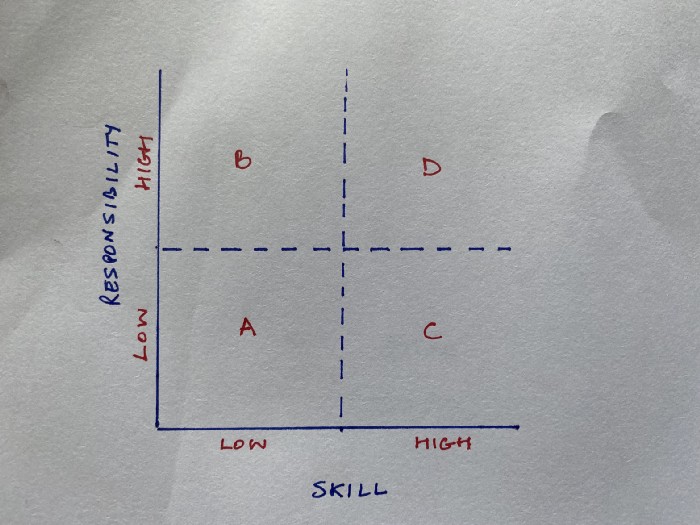How do I manage my subordinates?featured
Edit: The framework I have detailed below is the Skill-Will Matrix. As per the Internet, It was first derived in 1970s Paul Hersey and Ken Blanchard! My thanks to reader Kamonasish Aayush Mazumdar for identifying it.
In my first year as an entrepreneur, I was managing ten people. Soon, this number crossed fifty. This was a new challenge for me as in previous work as an analyst, only one person reported to me. My lack of skills in being a boss made it a very frustrating experience. I would assign a task to a colleague and discover on the due date that they had done something totally different from what I had asked them to do. Or that they had completed only a tenth of the work. I blamed this on my subordinates till it became obvious that the problem was at my end. At that time someone shared a simple framework for managing people with me. I found this framework immensely useful. Over the years, I have shared it with many entrepreneurs. Especially those who do not have too much experience of dealing with subordinates. In this post, I want to share this framework with you.
Let’s begin by imagining that you are setting your subordinate a task. The task could be as simple as writing a short program or much more complex one, say delivering a large project. Start by mentally rating your subordinate on their skill level for the task and on their sense of responsibility. That is, place them in one of the four quadrants in the chart below.

Note that these two attributes may not be highly correlated. I have had colleagues who were very responsible but did not understand their job very well (Quadrant B). I would assign them a task and discover a few days later that they had not understood what needed to be done. I have also worked with brilliant people who were not very responsible (Quadrant C). These people would understand what needed to be done but would underestimate the time they needed to do the task. Or their work would have many obvious ‘silly’ errors. You can get lucky and get people in D, but that is rare. It is more likely that your employee is in A. So how do you deal with this situation?
The heuristic is as follows
· For someone not very skilled with their job, you need to give very detailed instructions. Define the task as much as you can and make sure that your subordinate understands your instruction. It is possible that your employee says that they have understood what needs to be done when they have not. I found it useful to ask them to tell me what they understood. Sometimes we would have to do this multiple times.
· For someone not very responsible, you need to regularly monitor what they are doing. Break the task down into intermediate milestones and check their work regularly against those milestones. This monitoring needs to be at least a little formal. I have worked with brilliant people who would reply yes, if I just asked them if everything was on track. However, if I actually sat down with them to understand what they had accomplished, I would realize that they had barely begun. Many times, they were not lying, but simply assuming that their brilliance would somehow make things happen on time.
This is it. This simple trick, applied with discipline, reduced my frustrations with my employees significantly. It also reduced their frustrations with me!
Note that there can be situations when you yourself are not in D, especially in a startup. For example, imagine you are an entrepreneur with no experience in graphic design and you have asked someone to develop your pitch deck. In such a situation, it would not help to give them detailed instructions on fonts and designs but it would be crucial if you can nail down what you wish to communicate. If your designer is a D or a C, they would make sure that they extract this information from you. Your job would be to make sure that you set enough time and patience aside for this.
This framework is also useful for helping develop your colleagues. You need to help them move from A or B or C to D. That is, you need to help them upgrade their skills or their sense of responsibility. When they are a D and you are a D magic happens!
There are many more things to managing people and even more to being a leader. This simple framework however, can help you significantly.
The person who communicated this framework to me got it from their boss. Maybe their boss got it from someone else or maybe they got it from a book or journal. If anyone knows the originator of this framework, do comment. I would love to credit them. In the meanwhile, I just want to pay it forward and hope that it benefits someone who is frustrated in dealing with their subordinates.
Author –
Yogesh Upadhyaya
(Yogesh Upadhyaya is one of the founders of AskHow India. Blogs are personal views.)
You can follow AskHow India (@AskHowIndia) or me (@YogeshUpadh) on twitter or me on LinkedIn or Medium. DM me if you wish me to put you on WhatsApp distribution list.



